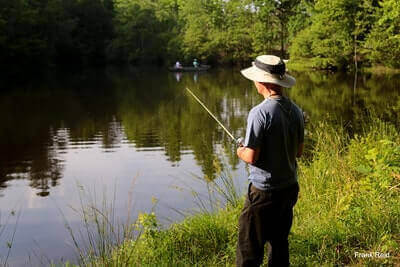Disclosure: We may earn commissions if you purchase products after clicking on a link from our site.
Do you want to learn how to fish in a pond? Do you want to quickly learn how to catch bass, catfish, crappie, sunfish, and other types of fish from a pond? Fishing in a pond has several advantages over a lake or a river. In this article, we discuss how to fish a pond so you can become successful whether for the thrill or for the catch you take home at the end of your fishing trip.
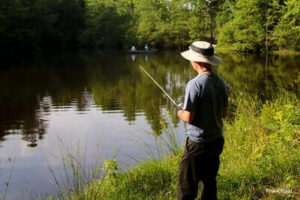
Table of Contents
How To Fish A Pond
- Time To Pond Fish
The best time to fish a pond is early in the morning or late in the evening at dusk. You will be more successful during these time periods than in other time periods. Fish in the pond are less active during the day when the temperature is much hotter than in the mornings or late evenings. When you are learning how to fish a pond, early morning and late evening are the best times to go fishing.
2. Downsize Your Gear
Maybe you have heard it a thousand times but you need to downsize your fishing rods. Fast-action, medium-light rods with spinning reels are some of the best for fishing in a pond. Don’t use any longer than six feet. When you are starting out and learning how to fish a pond, it is good to go with fishing rods that are not too long.
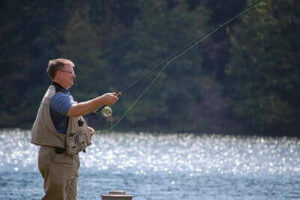
3. E-Scouting
Before going to a pond to fish, use Google Earth to look at the pond for the deep and shallow areas, grass lines, access points, inlets, boat docks, hubs, and other features of the pond. When you do get to the pond, you will have a good idea of the different areas and futures. Use Google Earth to get a good idea of the pond, its features, and its surroundings when you are learning how to fish a pond and are not familiar with the area.
4. Be Mindful of Your Steps
As you move along the shoreline, walk slowly and step lightly. The fish can pick up the vibration from the shoreline and they will be aware of your movements. When learning how to fish a pond, be mindful of all the noise and how heavy you step. You have to be aware of that and learn to reduce it significantly.
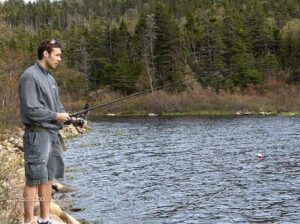
5. Trees Hanging Over Pond
Look for trees that are hanging over the pond. This is a prime area to target as fish will be in areas that provide cover from the sunlight. You can also find trees that are in the pond close to the shoreline or in a corner or pocket of the pond. This is also an area where you will find fish.
6. Structures Protruding Out of Pond
Look for structures that are protruding out of the pond. Structures like remnants of a boat dock, drain pipes, tree stumps, big rocks, etc. Fish, like Bass, like the structures and are usually around them.
7. Corners or Pockets Of The Pond
Look for pockets or the corners of the pond. It is even better if these corners or pockets have vegetation in them. Fish love these areas and are always resting there. They love to pile up in their pockets.
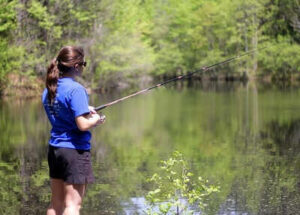
8. Creek Inlets
Look for areas where water is flowing into and out of the pond. The temperature will be cooler there and fish will always be in that area.
9. Water Fountains
If the pond is artificially created with a water fountain in the pond, then fish will be near the water fountain. Just like a creek inlet, they like the cooler temperature and will be around a water fountain.
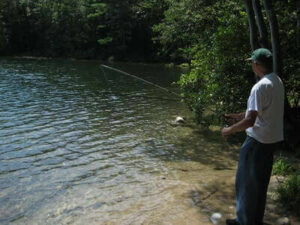
10. Fallen Trees In Water
If there are dead and fallen trees or old logs in the water, you can bet that fish will be in that area. Pond fish love to dwell around dead and fallen trees. They provide protection and cover. Bass like to suck up on the wood.
11. Water Color
Take a look at the color of the water to determine the color of the bait to use. If the color is fairly clear, you can go with natural color baits. if it is muddy waters, then baits for that type of water will work better.
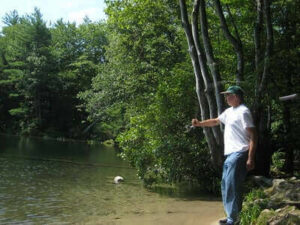
12. Deepest Part of The Pond
The satellite images from Google Earth can help identify the deep areas of a pond but when you are physically there, you want to cast your line and find the deepest areas of the pond. Fish will be close to that area as they will feel more secure in that part of the pond in case of anything. Start fishing from that area and work your way to the shallow areas.
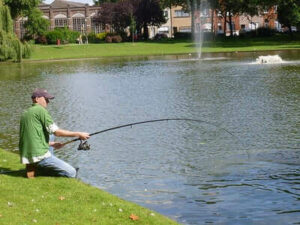
Baits For Pond Fishing
1. Drop Shot Bait
The drop shot rig is a highly effective technique used in pond fishing to target a variety of species, including bass, panfish, and trout. This rig consists of a lightweight hook tied above a small weight, typically placed 12-18 inches below. The drop shot bait, often a soft plastic lure like a worm, minnow, or creature bait, is then hooked through the middle or nose to create a natural presentation.
When fishing in ponds, the drop shot rig excels in targeting fish holding in deeper water or around structures such as submerged vegetation, rocks, or drop-offs. Anglers can adjust the length of the leader to position the bait at different depths, allowing for precise targeting of fish at varying levels in the water column.
The subtle movement of the drop shot bait, imparted by gentle twitches or shakes of the rod tip, entices strikes from wary fish without spooking them in the clear waters often found in ponds. Overall, the drop shot rig and it is accompanying bait offer pond anglers a versatile and finesse-driven approach to fishing that consistently produces results.
2. Lucky Crab Crankbait
The Lucky Craft Crankbait is a versatile and highly effective bait for pond fishing, particularly for targeting bass and other predatory species. This crankbait features a realistic design and lifelike action that mimics the movement of natural prey, making it irresistible to fish.
Its buoyant body allows it to dive to specific depths, making it ideal for fishing in ponds with varying depths and structures. The diving action of the Lucky Craft Crankbait allows anglers to cover a large area of water efficiently, searching for active fish along the way. Its rattling noise and vibrant color patterns further attract fish and trigger strikes, even in murky pond water.
Whether retrieved steadily or paused to allow it to float up, this crankbait can entice strikes from aggressive pond bass. With its reliable performance and proven track record, the Lucky Craft Crankbait is a go-to choice for pond anglers looking to land big fish.
3. Stick Worm Bait
The stick worm bait is a staple in the arsenal of many pond anglers due to its simplicity and effectiveness. This slender, soft plastic lure closely resembles a worm or small baitfish, making it irresistible to a wide range of freshwater species, including bass, crappie, and bluegill. Its elongated body and tapered ends create a natural and enticing swimming action when rigged weightless or with a lightweight hook.
Pond anglers often employ various techniques with stick worm baits, such as the wacky rig or Texas rig, to present the bait in different ways and target fish in varying depths and cover types. Whether fished along the surface, submerged near vegetation or dropped into deeper water, the subtle movements of the stick worm can provoke aggressive strikes from hungry pond fish.
Additionally, its soft and buoyant composition allows for lifelike movement even with minimal angler input, making it an excellent choice for novice and experienced anglers alike. Overall, the stick worm bait is a versatile and reliable option for pond fishing, capable of producing bites in a wide range of conditions and environments.
4. Spinner Bait
The spinner bait is a versatile and effective bait for pond fishing, renowned for its ability to attract a wide variety of predatory fish species. Comprising a wire frame adorned with one or more spinning blades, a skirt, and a hook, spinnerbaits offer anglers a dynamic lure option suitable for various water conditions and fish behaviors.
When retrieved through the water, the spinning blades create flashes and vibrations, mimicking the movement of fleeing prey and triggering aggressive strikes from lurking predators. Pond anglers often employ spinnerbaits around submerged vegetation, along the edges of weed beds, and near structures such as fallen trees or docks, where predatory fish like bass and pike are known to hide and ambush their prey.
The versatility of spinnerbaits allows anglers to adjust the retrieve speed, depth, and presentation style to match the preferences of the fish and the prevailing conditions. Whether cast and retrieved steadily, ripped through vegetation, or bounced along the bottom, spinnerbaits excel at eliciting reaction strikes from hungry pond predators. With their ability to cover water efficiently and entice aggressive bites, spinnerbaits are a go-to choice for many pond anglers seeking to maximize their catch rates and enjoy an exhilarating fishing experience.
5. Soft Plastics
Soft plastics are a staple bait for pond fishing, prized for their versatility, effectiveness, and a wide array of shapes, sizes, and colors. These artificial baits are typically made of soft, flexible materials such as silicone or plastic, molded into lifelike imitations of various aquatic creatures like worms, crayfish, and baitfish.
Pond anglers rely on soft plastics to target a multitude of freshwater species, including bass, panfish, and catfish, among others. Rigged on a jig head, Texas rig, Carolina rig, or drop shot rig, soft plastics can be presented in a variety of ways to entice strikes from fish at different depths and in various types of cover. Their lifelike action and natural appearance make them irresistible to hungry predators, especially in heavily fished ponds where fish may be wary of traditional baits.
Whether hopped along the bottom, fluttered through vegetation, or retrieved steadily through open water, soft plastics excel at fooling even the most discerning fish. Pond anglers often experiment with different soft plastic shapes, colors, and presentations to determine what the fish are biting on any given day, making them a versatile and indispensable addition to any angler’s tackle box.
6. Crawl Bait
Crawl bait, also known as crawfish or crayfish imitations, is a highly effective bait for pond fishing, particularly for targeting predatory species like bass and panfish. These baits mimic the appearance and movement of the crustaceans that inhabit freshwater ponds, making them irresistible to hungry fish.
Crawl baits are typically designed with lifelike details such as pincers, antennae, and segmented bodies, and they often feature realistic color patterns to further enhance their appeal. Anglers can fish crawl baits in a variety of ways, including casting and retrieving, flipping and pitching into cover, or dragging along the bottom. When retrieved, crawl baits exhibit a natural swimming action that closely resembles the erratic movements of live crayfish, enticing strikes from nearby predators.
Additionally, the soft plastic or rubber construction of crawl baits allows for added durability and flexibility, ensuring they can withstand repeated strikes and remain effective throughout a fishing session. Overall, crawl baits are a go-to option for pond anglers looking to tempt finicky fish with a lifelike and enticing presentation.
The Bottom Line
If you want to learn how to fish a pond, then after reading this article you will have the knowledge you need to begin your journey of successful pond fishing.
We discussed many of the things to do when you fish in a pond for you to be successful. If you fish for bass, this article on bass fishing tips will help you be a better bass angler. You can also read bank fishing tips to get more tips on how to successfully fish from the banks of rivers, ponds, lakes, etc.
